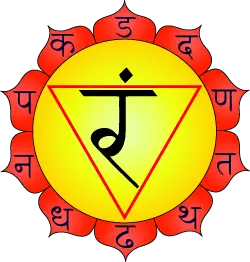 Nabhi bandha is also not discussed in detail in classical hatha yoga traditions. It is similar to uddiyana only in that it focuses upon the region near the navel, but uniquely nabhi bandha focuses four finger widths below it (half way between the swadhistana and the manipura). In nabhi bandha the upper part of the abdomen is not drawn in, but just the area below the navel.
Nabhi bandha is also not discussed in detail in classical hatha yoga traditions. It is similar to uddiyana only in that it focuses upon the region near the navel, but uniquely nabhi bandha focuses four finger widths below it (half way between the swadhistana and the manipura). In nabhi bandha the upper part of the abdomen is not drawn in, but just the area below the navel.
Thus it can be described as the pulling in of the abdomen below the navel, energizing and purifying the upper part of the water chakra and the lower part of the fire chakra — as such it is the liquid fire center. Although it can be performed in a physical, gross, coarse, and external manner utilizing muscles, it also is best seen as a subtle and internal energetic process.
Procedure:
It can be learned at first through its physical gross form by first implementing mula bandha and a light/subtle uddiyana bandha creating a lift in the torso and the spine up off the pelvis. Then allow the lower abdomen below the navel to move straight backwards toward the spine energizing the lower tan tien (hara). It can be performed subtly like this throughout the day during walking, sitting, asana, pranayama, mudra or meditation. It can also be done quickly like agni sara kriya (in and out motions), but with the lower abdomen only. This is called nabhi kriya.
Also nabhi bandha differs from agni sara and uddiyana bandha, as it is more stimulating when done with internal kumbhaka and reverse breath. Try nabhi bandha as a subtle adjunct to swadhi bandha while simultaneously activating mulabandha, uddiyana bandha, and vajroli mudra. Such an internal practice synchronized with the breath will move the energy through the lower chakras.
In the physical practice all the skin and fascia below the navel moves toward the spine but the pelvis, chest, and back do not move. Keep the scapula down toward the sacrum and armpit chest rotated in its open and lifted position. This is the same breath and bandha that we do with proper vase breathing. (See the chapter on pranayama)
Like uddiyana bandha, a proper mulabandha is necessary for an effective nabhi bandha. The pelvis is neither in retroversion nor anteversion, but rather in trans-integrity. In another sense nabhi bandha can be said to be a continuation of mula and swadhi bandha as it dynamically occurs between the pelvis and the navel. It is most pronounced during posterior tilts of the pelvis (retroversion) with the torso fixed, but is most valuable in anteversion of the pelvis.
Benefits:
One can imagine that with the combined effects of mulabandha and swadhi bandha the lower energies are harmonized activated, concentrated . and compounded below and behind the navel with great intensity . It creates energy and heat at the lower belly (tan tien in Chinese and hara in Japanese). Nabhi bandha stimulates, purifies, and balances the first three chakras especially balancing the apana and prana. It is especially able to cure diseases of apana deficiency when combined with effective mula, swadhi, and uddiyana bandhas. It is a specific tonic for the water/fire region and especially so for the prostate/ovaries, adrenals, assimilation (lower small intestines) , upper lumbar, and kidneys.
Like the other asanas and bandhas nabhi is most effective for those suffering from specific imbalances such as excessive lordosis (swayback), tightness of the groins, lack of hip extension, weak hip extensors, tight hip flexors, obesity, constipation,, weak iliopsoas, tight quadratus lumborum, lack of energy, lower back problems, and other maladies of that specific region.
As an energy lock, nabhi bandha can be implemented all the time, but it is most actively implemented physically at the end of uddiyana bandha (at the end of a full exhalation). After that is mastered, then advanced practitioners can actively implement nabhi bandha after a full inhalation (like uddiyana bandha) to top off an antar kumbhaka.
More commonly Nabhi bandha helps expel all the air out of the lungs when implemented at the end of exhalation (after uddiyana bandha). Also utilizing nabhi bandha (especially at the end of the inhalation) helps move the heart forward and upward — raising even the apex of the lungs, lengthening the spine, and providing the action of compounding, churning, and compaction of the inner heat that melts the hardness of the mind (such in the advanced practices of pranayama, tummo heat, and mudras, utilizing vase breathing (see the chapter on pranayama and mudras for more).
Caution:
Avoid any tension/tightness in the hara. Use nabhi bandha to soften the deep fascia of the lower abdomen, and remove hardness. Do not allow nabhi bandha to restrict the movement of the thoracic diaphragm and thus the depth of the incoming air. Rather allow the air and movement to completely penetrate all the way into the muladhara even more so by the application of nabhi bandha.
Realize that when the breath and prana is coursing deeply through the body/mind nabhi bandha happens by naturally itself, through grace. Thus it is not necessary to consciously implement, nor should one strive to hold it. However as an intentional conscious practice, when we explore and investigate the energy of this bandha in asana, meditation, pranayama, mudra, and the like, we find that we can also help alleviate obstruction, obscuration, energy stagnation, tension, imbalance, while not only allowing the energy to freely move but also augment distant energy centers as well as our overall energy, balance, and alignment.
